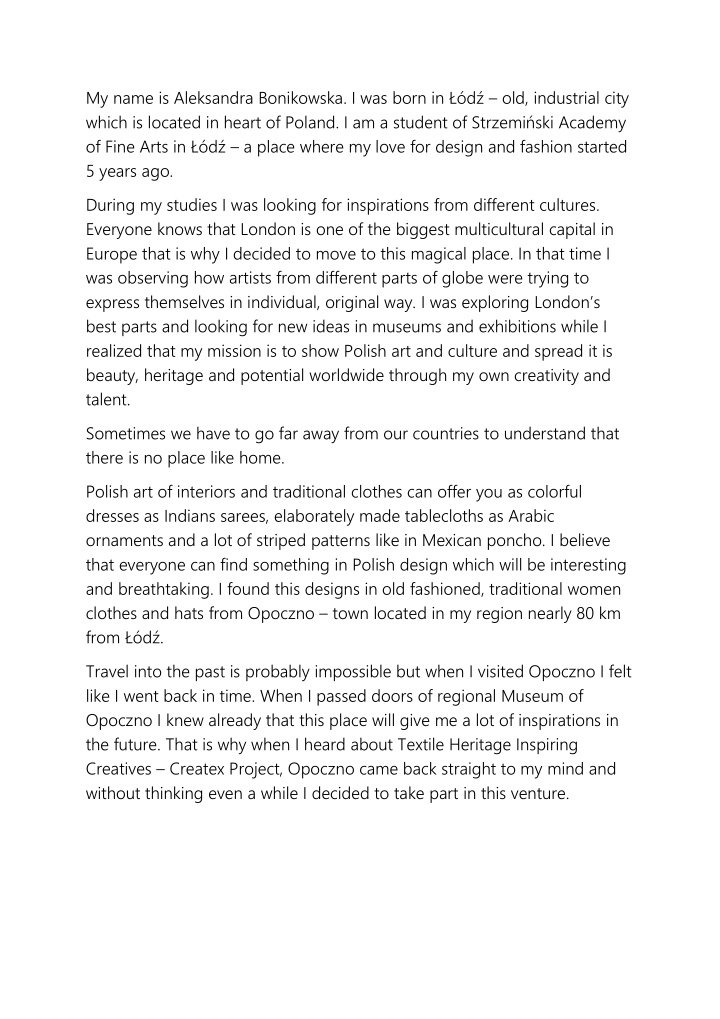



My name is Aleksandra Bonikowska. I was born in Łódź – old, industrial city which is located in heart of Poland. I am a student of Strzemiński Academy of Fine Arts in Łódź – a place where my love for design and fashion started 5 years ago. During my studies I was looking for inspirations from different cultures. Everyone knows that London is one of the biggest multicultural capital in Europe that is why I decided to move to this magical place. In that time I was observing how artists from different parts of globe were trying to express themselves in individual, original way. I was exploring London’s best parts and looking for new ideas in museums and exhibitions while I realized that my mission is to show Polish art and culture and spread it is beauty, heritage and potential worldwide through my own creativity and talent. Sometimes we have to go far away from our countries to understand that there is no place like home. Polish art of interiors and traditional clothes can offer you as colorful dresses as Indians sarees, elaborately made tablecloths as Arabic ornaments and a lot of striped patterns like in Mexican poncho. I believe that everyone can find something in Polish design which will be interesting and breathtaking. I found this designs in old fashioned, traditional women clothes and hats from Opoczno – town located in my region nearly 80 km from Łódź. Travel into the past is probably impossible but when I visited Opoczno I felt like I went back in time. When I passed doors of regional Museum of Opoczno I knew already that this place will give me a lot of inspirations in the future. That is why when I heard about Textile Heritage Inspiring Creatives – Createx Project, Opoczno came back straight to my mind and without thinking even a while I decided to take part in this venture.
When I was creating my set of furniture dedicated to interiors I thought about people who will see it as completed project. I wanted to expose Poland to them – country which is situated on the banks of Wisła river. The purpose of mine was to show artistic potential of my region. Wide range of traditional women’s clothing and typical hats – their interesting patterns and extraordinary decorations inspired me the most. I would like everyone to see easily how my puffs were made. Which weaves I used to created my projects with and how carefully is it done. I don’t expect from people to see in my furniture only creativity and innovation, I would like them to know as much as possible about source of my inspirations. That is why I am making my puffs in the same way how people in Opoczno were sewing their colorful costumes hundred years ago. To weave upholstery fabric for my puffs I am using foot – treadle operated loom. Almost every piece of my furniture is handmade in Łódź. This vision is making me proud because I believe that goods made by fast fashion industry will never have a soul like ones which are made by someone’s hands and creative mind. My unique collection, contain different kind of comfortable puffs. As I planned before -traditional for Opoczno deep, dark, green hue is a base of all of my furniture. To show typical polish patterns I decided to add to my projects bright color stripes. For me details have a huge role in all project, that’s why I decorated my furniture with multicolor, handmade pompons. The puffs are all designed to look great in vintage or retro interiors but they work too as interesting accompaniment in modern spaces. As well as being perfect for the living room, all of the puffs can be used to bring polish accent seating to the home office or bedroom.
Creative process: Foot – treadle operated loom , Strzemiński Academy of Fine Arts. Handmade pompons – a part of decorations.
Photos of all of mine inspirations: Apron (zapaska do pasa), Strzemiński Collection, made by Genowefa Błaszczyk in 1940. “ This kind of apron was worn with every wool dress, (…). Every woman had at least several aprons.” http://www.createxproject.eu/rspace/pages/view.php?ref=752&search=%21collection96&order_by =relevance&offset=96&restypes=&starsearch=&archive=0&per_page=48&default_sort_direction=DE SC&sort=DESC&context=Modal&k=&curpos=129 Rug, Strzemiński Collection , made in 20 th century, author is unknown.
Clothing fabric pattern repeats, Strzemiński Collection, made by Stanisława Telusiewicz in 20 th century. Crochet wool lace “ consists of a base with attached green stars and overlapping rings with yellow rims and green, pink or yellow centres, on which smaller yellow rings are added ” ; http://www.createxproject.eu/rspace/pages/view.php?ref=1621&search=%21collection96&order_b y=relevance&offset=0&restypes=&starsearch=&archive=0&per_page=48&default_sort_direction=DE SC&sort=DESC&context=Modal&k=&curpos=8 Strzemiński Collection; made by Zofia Pacan in 1976.
Handmade crochet boys’ hat, Strzemiński Collection, made in 20 th century.
Recommend
More recommend